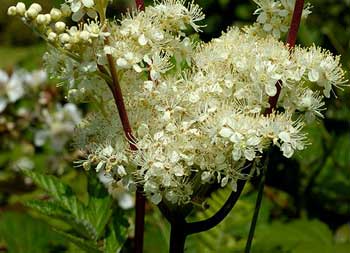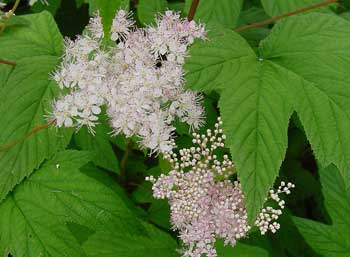Contents:
Common Names | Parts Usually Used | Plant(s) & Culture | Where Found | Medicinal Properties | Biochemical Information
Legends, Myths and Stories | Uses | Formulas or Dosages | Warning | Bibliography
Scientific Names

- Filipendula ulmaria L.
- Rosaceae
- Rose family
Common Names
- Bridewort
- Dolloff
- Lady of the meadow
- Meadsweet
- Meadow queen
- Meadow-wort
- Pride of the meadow
- Queen of the meadow
Parts Usually Used
The entire plant
Back to Top

Description of Plant(s) and Culture
Meadowsweet is a perennial plant; a creeping rootstock sends up a reddish, angular stem, 2-3 feet tall, branched near the top and bearing alternate, pinnate leaves, the leaflets entire or irregularly cleft, serrate, and downy white beneath. The terminal leaflet is 3-5 lobed and doubly serrate. Small yellowish-white or reddish flowers grow in panicled cymes from June to August. The sweetness comes from its tiny flowers that crown the top of each stem in dense clusters.
Another variety: Dropwort or goatsbeard (F. hexapetala) is a related European and Asian plant with a tuberous root and fernlike leaves. Medicinally it is equivalent to meadowsweet. Also, F. rubra, used much like meadowsweet.
Also called meadowsweet: (Spiraea tomentosa); (Eupatorium purpureum) also called Gravel Root and Joe-Pye Weed; and (Spiraea ulmaria).
Back to Top
Where Found
Very common in European damp meadows, on banks of streams and rivers; it can also be found in the eastern United States and Canada, as far west as Ohio.
Back to Top
Medicinal Properties
Astringent, diaphoretic, diuretic, antirheumatic, analgesic, antispasmodic
Back to Top
Biochemical Information
Salicylic aldehyde and spireine both in the form of a glycoside; methyl salicylate, gaultherine and spiraeoside, a flavonoid glycoside, sugar and tannin
Back to Top
Legends, Myths and Stories
Queen Elizabeth I was so fond of this herb that the floors of her apartments were always strewn with it.
Filipendula ulmaria (Spiraea ulmaria) probably contains chemical forerunners of aspirin. Salicin, the popular analgesic derived from poplars and willows, probably decomposes in the digestive tract to salicylic acid, a compound first isolated from meadowsweet flower buds in 1839. Some 60 years later, the pharmaceutical company Bayer produced acetylsalicylate, a similar substance, artificially. They called this new “wonder drug” aspirin, Spiraea ulmaria, the old botanical name for this herb. The semisynthetic acetyl-salicylic acid (aspirin) is said to have fewer side effects than the natural compound from which it is derived. Still, nonsteroidal anti-inflammatory drugs including aspirin, account for 10,000-20,000 deaths per year. Probably all medicines, natural and synthetic, have side effects.
The pleasing drink formula is as follows:
Equal quantities of meadowsweet, dandelion and agrimony boiled together for 20 minutes in double the quantity of water. Add 2 lb. of sugar to each gallon of strained liquid together with 1/2 oz. of yeast and the juice of a lemon. Leave the mixture to ferment and bottle later.
Back to Top
Uses
Meadowsweet contains salicylic acid, which makes it useful for colds, flu, fever, problems of the respiratory tract, gout, rheumatism, arthritis, dropsy, problems with water retention, and for bladder and kidney problems. Also is taken for diarrhea and dysentery, enteritis, gastritis, indigestion, heartburn, soothing and healing to the lining of the stomach, upset stomach, high blood pressure, diabetes, and disorders of the blood. Externally, the decoction can serve as a wash for wounds or sore eyes. It makes a pleasing and refreshing drink.
Back to Top
Formulas or Dosages
Harvest while flowering in summer.
Infusion: steep 2 tbsp. of the herb in 1 cup water. Take 1 cup a day.
Decoction: boil 1 tbsp. of the herb or dried root in 1 cup water. Take 1 cup a day. Or soak the dried root in cold water for 6 hours, bring to a boil and steep for 1-2 minutes.
Powder: take 1/4 to 1/2 tsp., 3 times a day.
Juice: take 1 tbsp. a day, in water.
Back to Top
Warning
Long use of aspirin can lead to gastric ulceration, possibly bleeding, but meadowsweet does not show these side effects, and is actually a gentle digestive remedy for acidity and some types of diarrhea.
Avoid this herb if sensitivity to salicylates (aspirin) is present.
Back to Top
Bibliography
![]() American Folk Medicine
American Folk Medicine, by Clarence Meyer, Meyerbooks, publisher, PO Box 427, Glenwood, Illinois 60425, 1973
![]() The Complete Medicinal Herbal
The Complete Medicinal Herbal, by Penelope Ody, Dorling Kindersley, Inc, 232 Madison Avenue, New York, NY 10016, First American Edition, copyright 1993
![]() Eastern/Central Medicinal Plants
Eastern/Central Medicinal Plants, by Steven Foster and James A. Duke., Houghton Mifflin Company, 215 Park Avenue South, New York, NY 10000
![]() Indian Herbalogy of North America
Indian Herbalogy of North America, by Alma R. Hutchens, Shambala Publications, Inc., Horticultural Hall, 300 Massachusetts Avenue, Boston, Massachusetts 02115, 1973
![]() The Herbalist Almanac
The Herbalist Almanac, by Clarence Meyer, Meyerbooks, publisher, PO Box 427, Glenwood, Illinois 60425, copyright 1988, fifth printing, 1994
![]() The Herb Book
The Herb Book, by John Lust, Bantam Books, 666 Fifth Avenue, New York, NY. copyright 1974.
 The Magic of Herbs
The Magic of Herbs, by David Conway, published by Jonathan Cape, Thirty Bedford Square, London, England. (Out of print)
![]() Planetary Herbology
Planetary Herbology, by Michael Tierra, C.A., N.D., O.M.D., Lotus Press, PO Box 325, Twin Lakes. WI 53181., Copyright 1988, published 1992
![]() Webster’s New World Dictionary
Webster’s New World Dictionary, Third College Edition, Victoria Neufeldt, Editor in Chief, New World Dictionaries: A Division of Simon & Schuster, Inc., 15 Columbus Circle, New York, NY 10023
